|
Pickford's Wharf
In the 1780s Pickfords began transporting goods on
the canals. In the mid 1790s they had 10 boats, and
by 1820 the number had increased to 80, rising to
120 by 1840. Pickford's Wharf at Wolverhampton
opened in 1821 on the southern side of the Minerva
Iron and steel Works branch. The company ran a number of 'fly'
boats which ran non-stop day and night delivering
important and perishable goods throughout the canal
network. They were drawn by teams of galloping
horses ridden along the towing path and changed at
regular intervals. The boats had the right of way
over all other traffic, particularly at locks. The
scale of the operation can be judged by the large
number of destinations that goods could be sent to
every day, except Sunday, including:
Tipton, Worcester, Gloucester,
Bristol, Tewkesbury, Gainsborough, Sheffield,
Chesterfield, Nottingham, Derby, and Leicester.
Every night except Sunday boats went to:
Liverpool, Manchester, Preston
Brook, Chester, Warrington, Stockport, The
Potteries, Newcastle, Congleton, Macclesfield, Leek,
Huddersfield, Halifax, Bradford, and Leeds.
Also on Mondays, Wednesdays, and Fridays to:
Kidderminster, and Stourport.
The
company initially tried to compete with the
railways, but by the mid 1840s advertised as railway
and canal carriers. Eventually road traffic
prevailed and their canal operation ceased. At one
time or another the company had offices in Berry
Street, Fryer Street, and later Great Brickkiln
Street, all in Wolverhampton. |

The location of Pickford's Wharf.
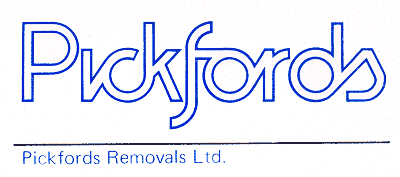
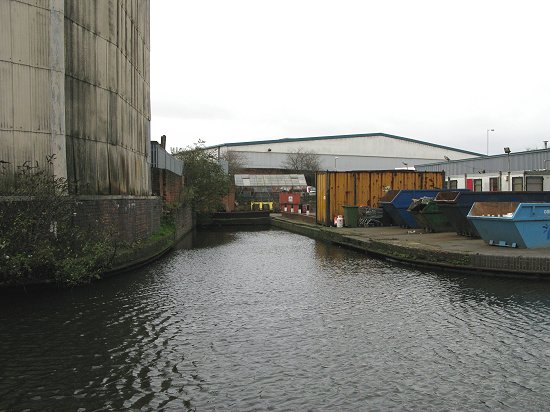
Pickford's Wharf as it is today.
| The basin extended beyond Pickford's Warf as
far as Shakespeare Passage, which ran off
Shakespeare Street. It included several other
wharves and was used by the adjacent manufacturers. |
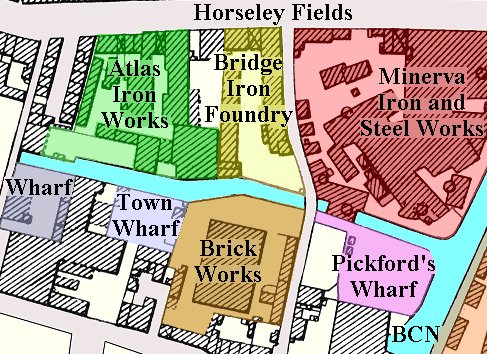
A map showing the full extent of the
basin.
| Bridge Iron
Foundry On the northern side of the basin, on the corner
of Minerva Lane and Horseley Fields stood the Bridge
Iron Foundry, established in 1845.
The business was run by Thomas Bridges
and Sons and produced all types of castings for
machinery, and steam engines.
It was also listed as a
tool and lathe manufacturer in 1894.
The works
produced a wide range of products including
hydraulic presses, condensing steam engines, and
corrugating machines for the manufacture of
corrugated iron.
|
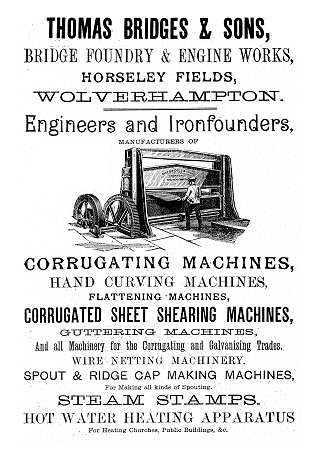
An advert from 1896. |
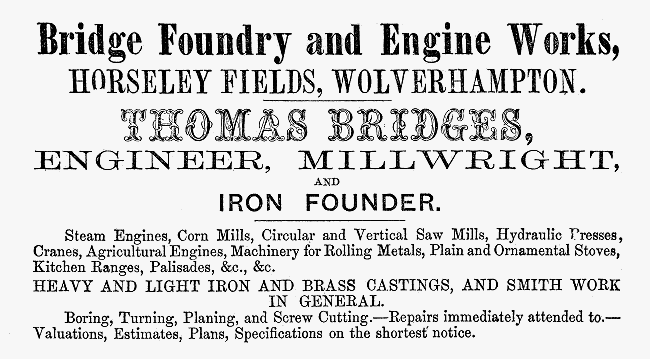
An advert from 1861.
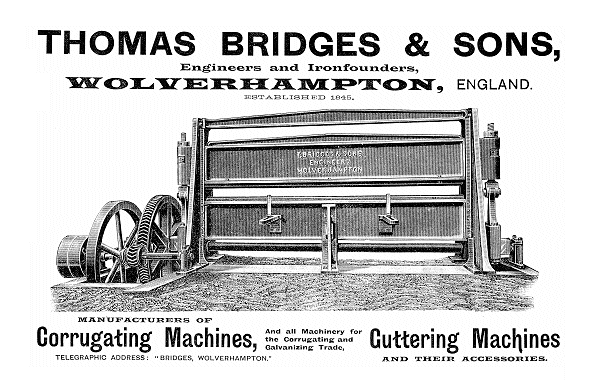
An advert from 1896.
|
Atlas Iron Works
The next
wharf on the northern side of the basin belonged to
the Atlas Iron Works. The works were owned and run
by John Whitehouse and produced a wide range of
products.
The company specialised in ironwork for
ship builders and riggers, such as shackles,
clip-hooks, tackle-hooks, and ship's scrapers. Other products included wrought iron hinges,
horseshoes and crowbars. Town Warf stood halfway along the southern side
of the basin, with its own coal yard.
In the 1960s
F. J. Evans, coal merchants were based there.
Between it and Minerva Lane, in the late 19th
century was a brick works. Today over half of the
basin has gone, it now only extends to about halfway
between the canal and Minerva Lane. |
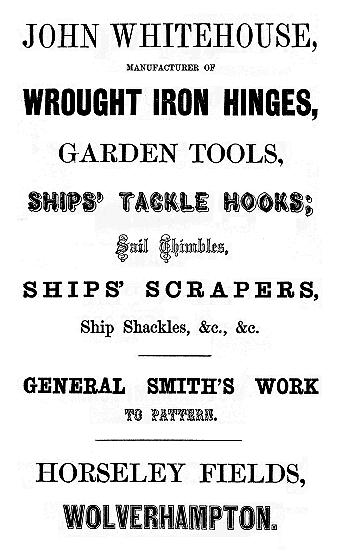
An advert from 1861. |
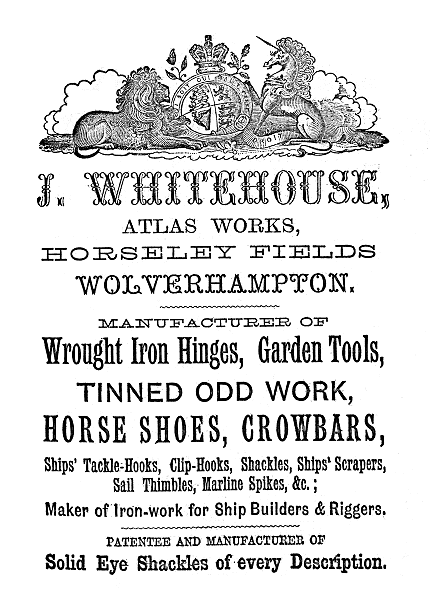
An advert from 1879.
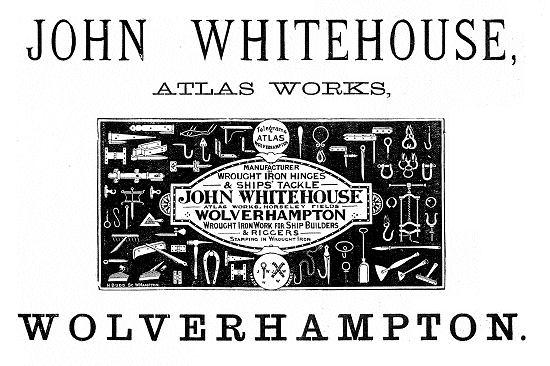
|
Adolphe Crosbie &
Company
Paint manufacturer Adolphe Crosbie opened for
business in Walsall Street, on the southern side of
the branch in 1875. In its early years the company
also had a waste acid factory and a number of canal
boats. |
|

Adolphe Crosbie. |
Adolphe Crosbie lived at the Hollies, Larches
Lane, Wolverhampton. He was born in Westbourne Park,
London, and educated at Notting Hill Collegiate
School. He qualified as a teacher of phonetic
shorthand. He was a member of the Society of
Chemical Industry, the Wolverhampton Chamber of
Commerce, the Birmingham Exchange, and the Phonetic
Society.
He was a Conservative member of Wolverhampton
Council from 1892 until 1895, and in 1901. He was
keen on amateur athletics and used to compete in
meetings of the London Athletic Club. He greatly
enjoyed playing tennis and became Captain of the
Staffordshire lawn tennis team. He regularly played
at the Newbridge Lawn Tennis Club, where he became
match secretary. He was also a popular Rugby
referee. In his earlier years he lived for a time in
South Africa. |

An advert from 1899.
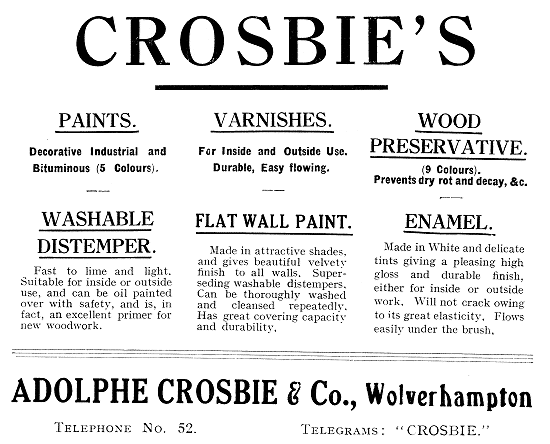
An advert from 1929.
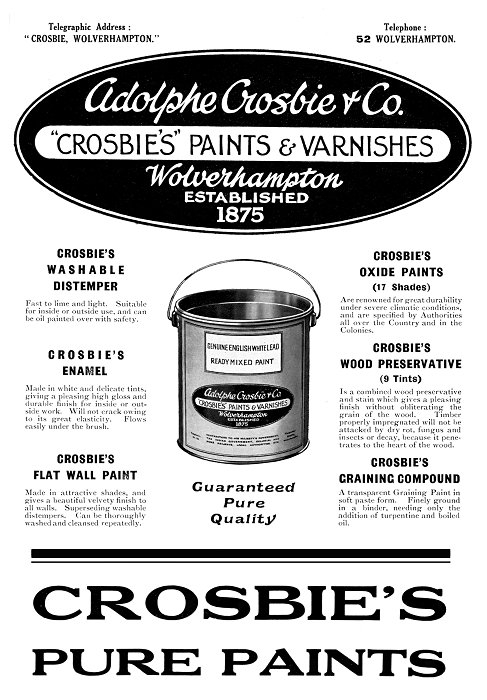
An advert from 1930.
|
Over the years Crosbies has
manufactured a wide range of paints and varnishes,
sold under the 'Wulfruna' and 'Crodurol' brand
names.
In the 1920s the company's
products included a range of coatings for the
shipping industry, including the following:
Anti-Corrosive Composition, Anti-Fouling
Composition, Boot Topping, Odourless White Enamel,
white and coloured enamels for cabins etc., and all
classes of varnish and oxide paint for ships use.
Crosbie's boiler composition was a successful
product that prevented scale and incrustation and
was recommended by many of the insurance companies. Other products include industrial metal
primers and finishes, wood primers and
preservatives, stove enamels, water-based emulsions,
dry colours, paint for colouring cement, bituminous
paints, and 'Scrumdurol' graining compound. |
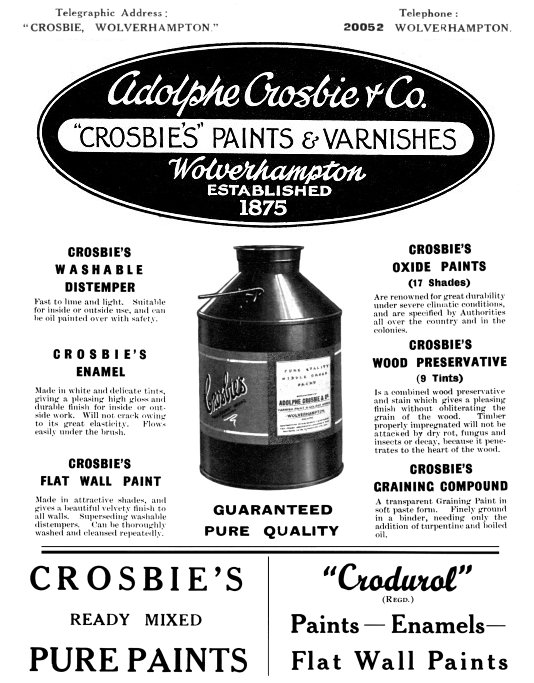
An advert from 1936.
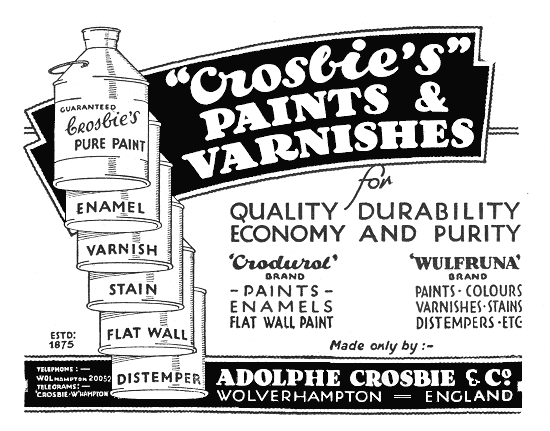
An advert from 1942.
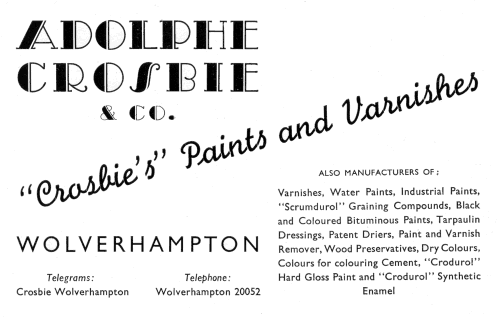
An advert from 1953.
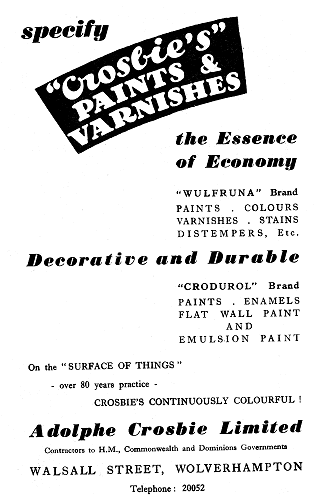
An advert from 1958.
|
In 1970 Crosbies were acquired
by Thomas Varty. Sadly, a great catastrophe occurred
in 1972 when much of the factory and the
manufacturing equipment were destroyed in the
largest fire the town had seen since the Second
World War. Thanks to the efficient workforce,
production continued and the factory was rebuilt. As
a result of the fire, the company decided to acquire
additional factories to ensure its survival, in the
event of a similar disaster in the future.
In 1973 Griffiths Bros, who
manufacture ‘Airspeed’ coatings were acquired,
followed by Manchester based Williams Casco
Limited. In its later years the company produced a wide
of diverse products including
floor coatings, and varnish and enamels for
the electrical industry, particularly suitable for
electric motors. |
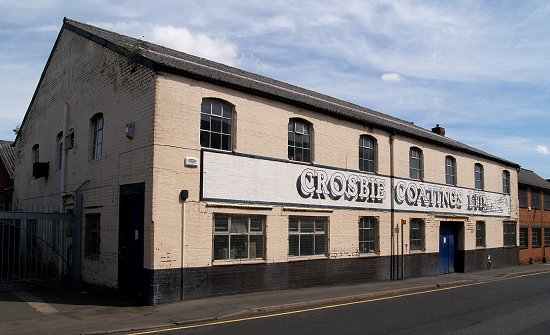
Crosbie's factory, as seen in 2016.

The business went into liquidation in April 2018, as can be seen
in the following notice from The Gazette:

 |
Return to the Canals
and Industry Menu |
|